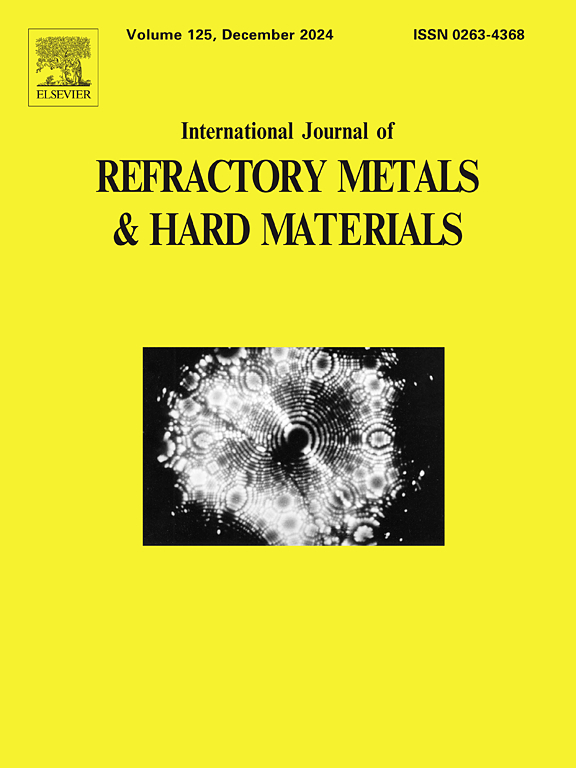利用强剪切应变调节WNiCo合金再结晶动力学
IF 4.2
2区 材料科学
Q2 MATERIALS SCIENCE, MULTIDISCIPLINARY
International Journal of Refractory Metals & Hard Materials
Pub Date : 2025-05-06
DOI:10.1016/j.ijrmhm.2025.107219
引用次数: 0
摘要
本研究探讨了在选定的旋转锻压制度下进行的强剪切应变处理对WNiCo钨重合金的再结晶动力学和变形行为的影响。单轴热压缩试验和全面的显微组织观察结果表明,选择的旋转锻压制度,特别是锻压温度,不仅显著影响动态硬化/软化过程的发生和发展,从而影响流动应力,而且影响再结晶动力学。1100℃的变形温度足以引发NiCo基体的动态再结晶,其平均晶粒尺寸降至1.9 μm。1200℃的变形温度使基体内部进一步软化,塑性流动加剧,也有利于W团聚体的加入。特别是高挤压温度与高应变速率(100 s−1)相结合,产生的流动应力最大值超过1100mpa。从计算的角度来看,通过建立流变模型,预测了WNiCo合金在广泛温度范围内的流变应力发展,绘制了发生的结构形成现象对WNiCo合金行为的复杂影响。通过对实验数据的回归分析,建立了流变模型,为有限元数值模拟奠定了基础。本文章由计算机程序翻译,如有差异,请以英文原文为准。
Adjusting recrystallization kinetics of WNiCo alloy by intensive shear strain
The study investigates the effects of intensive shear strain processing, performed by selected regimes of rotary swaging, on recrystallization kinetics and deformation behaviour of a WNiCo tungsten heavy alloy. The results of uniaxial hot compression tests and thorough microstructure observations indicate that the selected rotary swaging regime, especially the swaging temperature, influences significantly not only the occurrence and development of dynamic hardening/softening processes, which consequently influence the flow stress, but also the recrystallization kinetics as such. The deformation temperature of 1100 °C was sufficient to initiate dynamic recrystallization in the Ni![]() Co matrix, the average grain size within which decreased down to 1.9 μm. The deformation temperature of 1200 °C caused further softening within the matrix and intensified its plastic flow, which also supported joining of W agglomerates. Particularly the high swaging temperatures in combination with high strain rates (100 s−1) imparted flow stress maxima exceeding 1100 MPa. From the computational perspective, the complex effect of the occurring structure-forming phenomena on the behaviour of the WNiCo alloy was mapped by creating a rheological model, predicting its flow stress development under a wide range of temperatures. The rheological model was created via a regression analysis on the experimental data, and can serve as a basis for prospective numerical simulations using the finite element method.
Co matrix, the average grain size within which decreased down to 1.9 μm. The deformation temperature of 1200 °C caused further softening within the matrix and intensified its plastic flow, which also supported joining of W agglomerates. Particularly the high swaging temperatures in combination with high strain rates (100 s−1) imparted flow stress maxima exceeding 1100 MPa. From the computational perspective, the complex effect of the occurring structure-forming phenomena on the behaviour of the WNiCo alloy was mapped by creating a rheological model, predicting its flow stress development under a wide range of temperatures. The rheological model was created via a regression analysis on the experimental data, and can serve as a basis for prospective numerical simulations using the finite element method.
求助全文
通过发布文献求助,成功后即可免费获取论文全文。
去求助
来源期刊
CiteScore
7.00
自引率
13.90%
发文量
236
审稿时长
35 days
期刊介绍:
The International Journal of Refractory Metals and Hard Materials (IJRMHM) publishes original research articles concerned with all aspects of refractory metals and hard materials. Refractory metals are defined as metals with melting points higher than 1800 °C. These are tungsten, molybdenum, chromium, tantalum, niobium, hafnium, and rhenium, as well as many compounds and alloys based thereupon. Hard materials that are included in the scope of this journal are defined as materials with hardness values higher than 1000 kg/mm2, primarily intended for applications as manufacturing tools or wear resistant components in mechanical systems. Thus they encompass carbides, nitrides and borides of metals, and related compounds. A special focus of this journal is put on the family of hardmetals, which is also known as cemented tungsten carbide, and cermets which are based on titanium carbide and carbonitrides with or without a metal binder. Ceramics and superhard materials including diamond and cubic boron nitride may also be accepted provided the subject material is presented as hard materials as defined above.

 求助内容:
求助内容: 应助结果提醒方式:
应助结果提醒方式:


